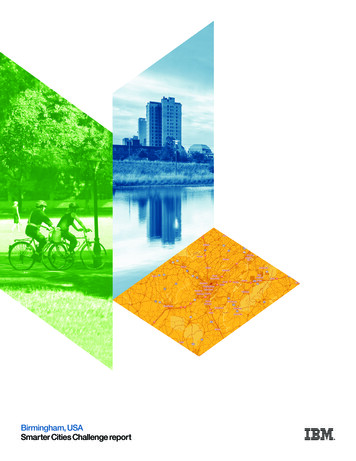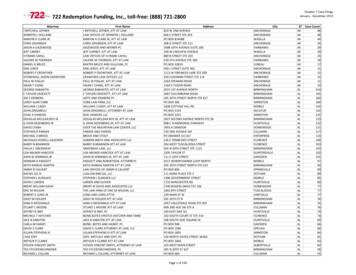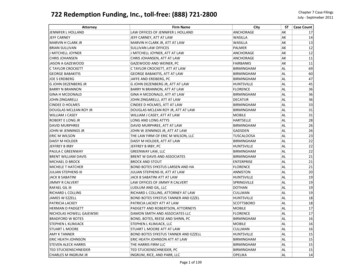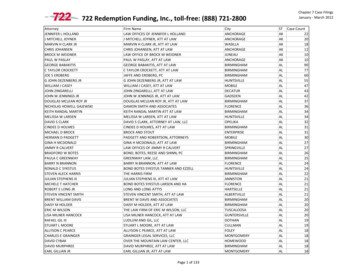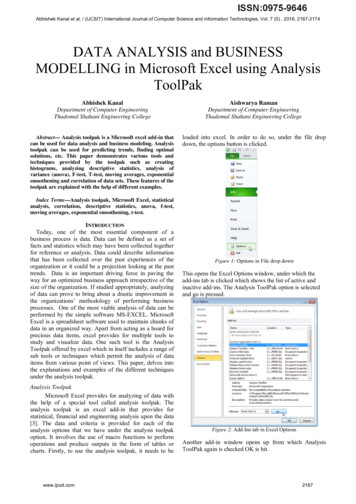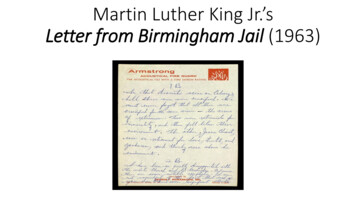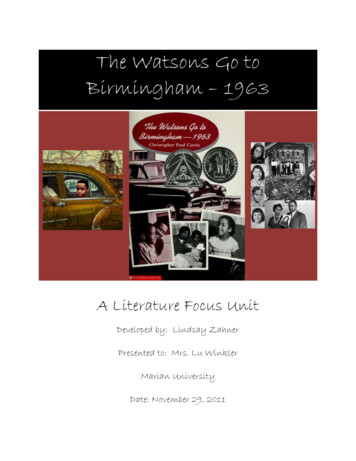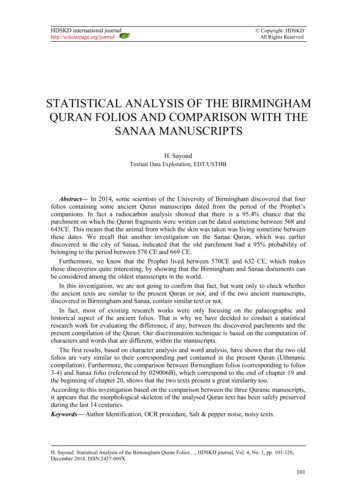
Transcription
HDSKD international journal Copyright HDSKDAll Rights Reservedhttp://scholarpage.org/journalSTATISTICAL ANALYSIS OF THE BIRMINGHAMQURAN FOLIOS AND COMPARISON WITH THESANAA MANUSCRIPTSH. SayoudTextual Data Exploration, EDT/USTHBAbstract— In 2014, some scientists of the University of Birmingham discovered that fourfolios containing some ancient Quran manuscripts dated from the period of the Prophet’scompanions. In fact a radiocarbon analysis showed that there is a 95.4% chance that theparchment on which the Quran fragments were written can be dated sometime between 568 and645CE. This means that the animal from which the skin was taken was living sometime betweenthese dates. We recall that another investigation on the Sanaa Quran, which was earlierdiscovered in the city of Sanaa, indicated that the old parchment had a 95% probability ofbelonging to the period between 578 CE and 669 CE.Furthermore, we know that the Prophet lived between 570CE and 632 CE, which makesthose discoveries quite interesting, by showing that the Birmingham and Sanaa documents canbe considered among the oldest manuscripts in the world.In this investigation, we are not going to confirm that fact, but want only to check whetherthe ancient texts are similar to the present Quran or not, and if the two ancient manuscripts,discovered in Birmingham and Sanaa, contain similar text or not.In fact, most of existing research works were only focusing on the palaeographic andhistorical aspect of the ancient folios. That is why we have decided to conduct a statisticalresearch work for evaluating the difference, if any, between the discovered parchments and thepresent compilation of the Quran. Our discrimination technique is based on the computation ofcharacters and words that are different, within the manuscripts.The first results, based on character analysis and word analysis, have shown that the two oldfolios are very similar to their corresponding part contained in the present Quran (Uthmaniccompilation). Furthermore, the comparison between Birmingham folios (corresponding to folios3-4) and Sanaa folio (referenced by 029006B), which correspond to the end of chapter 19 andthe beginning of chapter 20, shows that the two texts present a great similarity too.According to this investigation based on the comparison between the three Quranic manuscripts,it appears that the morphological skeleton of the analysed Quran text has been safely preservedduring the last 14 centuries.Keywords— Author Identification, OCR procedure, Salt & pepper noise, noisy texts.H. Sayoud. Statistical Analysis of the Birmingham Quran Folios ., HDSKD journal, Vol. 4, No. 1, pp. 101-126,December 2018. ISSN 2437-069X.101
HDSKD international journalhttp://scholarpage.org/journal Copyright HDSKDAll Rights ReservedI. IntroductionIn this section we will give a brief description and history on the two old parchments, namely:Birmingham Quran and Sanaa Quran.I.1 Introduction on the Birmingham Quran manuscriptThe Birmingham Quran folios belong to what is commonly known as the ‘Mingana Collection’.The core Mingana Collection, of manuscript fragments, was built up between 1924 and 1929through the common interest and energy of Dr. Edward Cadbury and Alphonse Mingana.Edward Cadbury, owner of family's chocolate factory at Bournville, sponsored AlphonseMingana in three journeys to the Middle East, and subsequently engaged Mingana to cataloguemuch of the collection. This must represent one of the last such European Orientalist enterprisesundertaken to scour the Middle East for manuscripts.When Mingana worked in Manchester, from 1915-1932, cataloguing the Arabic manuscripts ofthe John Rylands Library, Edward Cadbury sponsored him to undertake three journeys to theMiddle East to collect manuscripts. In the spring of 1924 in Lebanon, Syria and Iraq, Minganaacquired twenty two Arabic and some Syriac manuscripts for the John Rylands Library andother Syriac manuscripts for Cadbury. A visit in the autumn of 1925 to Syria, Iraq and SouthKurdistan yielded mostly Syriac manuscripts with some Arabic ones. Another in 1929 to SinaiPeninsula (St. Catherine's monastery) and Upper Egypt produced mostly Arabic manuscripts,with some Coptic and Greek ones (Hunt, 1997).The history of Arabe 328 of which Arabe 328c is a part, is easier to trace. This manuscript of theQuran along with a great many others was acquired by Jean-Louis Asselin de Cherville in 1822,consular agent of France in Egypt. Subsequently in 1833 the whole collection was sold to theBibliothèque Nationale of Paris. The ultimate provenance of all these folios is the “Amr bnu alĀAs” mosque, in Fustat. Thus, it is likely the Birmingham part of this manuscript was acquiredby Mingana whilst he was travelling in Egypt.In 2009, some researchers of Islamic-Awareness suggested that M. 1572 and Arabe 328c shouldbelong to the same codex (Islmic Awareness, 2015). In 2011 a detailed study regarding thehistory and provenance of this manuscript was made by Alba Fedeli who established that M.1572 comprised two distinct manuscripts (Fedeli 2015). Folios 1 and 7, namely MinganaIslamic Arabic 1572a, belonged to the same codex as Arabe 328c and the remaining sevenfolios, 2-6, 9, namely Mingana Islamic Arabic 1572b, belonged to the same codex as Marcel 17(National Library of Russia) and Ms. 67 (Museum of Islamic Art, Doha, Qatar) (Dreibholz,1995).The Birmingham Quran manuscript consists in four pages made of parchment, written in ink,and containing parts of chapters 18, 19 and 20 of the holy Quran (Fedeli, 2015). The manuscriptforms part of the University of Birmingham’s Mingana Collection of Middle Easternmanuscripts, held in the Cadbury Research Library (Birmingham, 2015).Sir Cadbury (the Birmingham-based Quaker philanthropist and businessman) named thiscollection “the Mingana Collection” after its first curator (Hopwood, 1961). The collectioncame to the University of Birmingham in the late 1990s. Concerning the palaeographic aspect ofH. Sayoud. Statistical Analysis of the Birmingham Quran Folios ., HDSKD journal, Vol. 4, No. 1, pp. 101-126,December 2018. ISSN 2437-069X.102
HDSKD international journalhttp://scholarpage.org/journal Copyright HDSKDAll Rights Reservedthe manuscript (Titled Hejazi text), the handwriting geometry suggests that it may have beencreated in the Hejaz area in the west of the Arabian Peninsula, which includes the sacred citiesof Mecca and Medina. In fact, there are several old manuscripts dating from the first centuriesafter the Hijra, where we can clearly see the difference in the palaeographic style (Awwad,1982). The palaeography can give a quite good estimation on the probable date of themanuscript, but the radiocarbon dating is usually more accurate whith regards to the parchmentdating. This last technique is widely used in archaeological dating (Taylor, 1997).Thus, the radiocarbon analysis, made at the Radiocarbon Accelerator Unit of Oxford University(Ramsey, 2009), yielded the following technical dating results (Higham , 2018) (Birmingham,2016): Radiocarbon Reference: OxA-29418 Radiocarbon Result: δ13 C -21.0 ‰ 1456 /-21 Calibrated Date Range: 95.4% probability to be between 568 and 645 ADFigure 1: Calibrated carbon-dated curve of Birmingham parchment, obtained with Oxcal software.The technical results were recently published in Datelist, Archaeometry journal of OxfordUniversity (Higham , 2018) and the date calibration (figure 1) was obtained with Oxcal software(Ramsey, 2017).Hence, the manuscript has been radiocarbon-dated by the University of Oxford (RadiocarbonAccelerator Unit) to the date range of 568–645 CE with a 95.4% degree of confidence. Theradiocarbon result means that the animal from which the skin was taken was living sometimebetween these specific dates. This places the discovered parchment close to the death of theProphet who lived between 570 and 632 CE.Some researchers argued that the manuscript is among the earliest written textual document ofthe Quran known to survive, which was written few years after the Prophet death. They alsoH. Sayoud. Statistical Analysis of the Birmingham Quran Folios ., HDSKD journal, Vol. 4, No. 1, pp. 101-126,December 2018. ISSN 2437-069X.103
HDSKD international journalhttp://scholarpage.org/journal Copyright HDSKDAll Rights Reservedclaim that it should probably be the oldest Quran manuscript in the UK.That is, in this investigation, we try to check whether the ancient text is similar to thecorresponding Sanna Quran part and to the present Uthmanic Quran by means of comparativeanalysis.I.2. Introduction on the Sanaa Quran manuscriptIn 1965 heavy rains damaged the roof construction of the Western Library in the Great Mosqueof Ṣanʿāʾ. A single window was discovered to contain a substantial cache of used Arabicmanuscripts, almost all being ancient manuscripts of the Quran spanning the first few Islamiccenturies. A Colloquium on the Islamic City organised by the World of Islam Festival Trust,sponsored by UNESCO, was held at the University of Cambridge, in July 1976. Drawing a widevariety of experts from both the Muslim and non-Muslim world, a number of specific researchactivities were recommended, amongst which was highlighted the pressing need to conserve therich corpus of Quranic texts discovered in the Mosque of Ṣanʿāʾ (UNESCO, 1980).The Ṣanʿāʾ collection was made known to the general public with the publication of MaṣāḥifṢanʿāʾ in 1985, an exhibition catalogue presenting some of the findings of the project. A singlepalimpsest folio from the part of the codex located in Dār al-Makhṭūtāt (i.e., DAM 01-27.1),folio 21a according to Sadeghi and Goudarzi’s classification, was displayed along with somebrief comments regarding the script and its contents. The folio was tentatively dated to the firsthalf of the 1st century of hijra (Sanaa, 1985).In 2004 Sergio Noseda had an article published describing his visit to Ṣanʿāʾ in 2002, in order toexamine, organise and photograph those manuscripts that would become part of the forthcomingvolumes of his « Sources De La Transmission Manuscrite Du Texte Coranique » (Noseda,2004). The same year Noseda’s visit to Ṣanʿāʾ was published, the researcher Razan GhassanHamdoun submitted her master’s thesis titled “The Quranic Manuscripts In Ṣanʿāʾ From TheFirst Century Hijra And The Preservation Of The Quran” to Al-Yemenia University (Hamdoun,2004). She used images provided by her father Professor Ghassan Hamdoun, and the mainsubject of her thesis was the analysis and discussion of one early manuscript of the Quranlocated in al-Maktaba al-Sharqiyya (i.e., the Eastern Library), the Great Mosque, Ṣanʿāʾ. Shenoted, amongst other things, that the manuscript was written on parchment and consisted of 72plates (i.e., 40 folios). It had the approximate dimensions of 35 cm x 26.5 cm, though the size ofeach folio was variable across the manuscript. On average there were 28 lines per page andacross a selection of 5 folios there were 24-32 lines per page, but that could be even less or moreon some pages. Unknown to Hamdoun, she had made known the most remarkable manuscript‘(re)discovery’ of the Quran since 1965-1972. These 40 folios belonged to the same manuscriptas DAM 01-27.1, collectively referred to today as codex Ṣanʿāʾ I. Hamdoun was not alone inbeing unaware of the importance of her edition in relation to the other parts of manuscriptextant.In 2010 Sadeghi and Bergmann had published their article analysing the four auction folios,specifically the Sotheby’s 1993 / Stanford 2007 folio, where details were given of a radiocarbonH. Sayoud. Statistical Analysis of the Birmingham Quran Folios ., HDSKD journal, Vol. 4, No. 1, pp. 101-126,December 2018. ISSN 2437-069X.104
HDSKD international journal Copyright HDSKDAll Rights Reservedhttp://scholarpage.org/journalstudy corroborating the early date already assigned to the manuscript. Analysis was done at theAccelerator Mass Spectrometry Laboratory of the University of Arizona (Sadeghi, 2010).According to Sadeghi and Bergmann, the results indicated that the parchment had a 95% (2σ)probability of belonging to the period between 578 CE and 669 CE.That is, in our investigation, we are particularly interested in the parchment referenced by thereference 029006B, which is characterized by the following table. We would like to make astatistical comparison of this manuscript with its corresponding part in Birmingham folios andthe present Uthmanic compilation.Table 1: Features of the investigated Sanaa folio.S.No. CATALOUGE NO. of MS.01-29.1DATE(AH)early firstCONTENT19:9020:40STYLEItalic HijaziSIZE (CM)42x29PHOTO029006 BI.3. Goal of this workMost of existing research works were mainly focusing on the palaeographic and historicalaspect of the ancient folios. That is why we have decided to conduct a statistical research workfor evaluating the difference, if any, between the discovered parchments and the presentcompilation of the Quran. That is, in this investigation, we try to check whether the ancient textis similar to the corresponding Sanna Quran part and to the present Uthmanic Quran by meansof comparative analysis. The used discrimination technique is based on the computation ofcharacters and words that are different, within the manuscripts. Finally, one tries to make aglobal comparison between all the available documents.II. Notes on the ancient Arabic handwritingIn this section we will present a short overview on some particularities of the ancient Arabictext. In fact, the Arabic script had a great importance within Islamic civilization and the mostsignificant document is the holy Quran. Over the time, a great variety of manuscript copies ofthe Quran survived, along with commentaries written by several ancient scholars. Furthermore,a large exploration of the ancient Arabic manuscripts shows how the Quran, in terms ofcalligraphy and decoration, evolved over the time in different geographical regions and cultures(Ansorge, 2011).II.1 Hijazi scriptThe earliest Quran manuscripts were probably written in the 7th century. Its script represents avery early Quran text written on a single large sheet of parchment and folded in half. Thisprimitive script is known as hijāzi script, which is originated from the Arabian Peninsula aroundMecca and Medina. The hijāzi script is characterized by tall and sloping letters representing theH. Sayoud. Statistical Analysis of the Birmingham Quran Folios ., HDSKD journal, Vol. 4, No. 1, pp. 101-126,December 2018. ISSN 2437-069X.105
HDSKD international journalhttp://scholarpage.org/journal Copyright HDSKDAll Rights Reservedconsonants. Also, one can find few dots and other markings indicating pronunciation or pausespa(Ansorge, 2011).Figure 2: Leaf of an early copy of the Quran written in hijāzi script on parchment. (add.1125, CambridgeUniversity)II.2. Kufic scriptThe kufic script is characterised by its caligraphic shape, which was originated from Kūfa,Kūfa Iraq.It probably dates from the 9th century. The Kufic Quran is written on parchment anddistinguished by lettering with very short vertical and elongated horizontal strokes. Vowels areindicated by red or green dots and the roundels mark the ends of thethe verses. Furthermore, thepage width is usually greater than its length (Ansorge,(2011).H. Sayoud. Statistical Analysis of the Birmingham Quran Folios ., HDSKD journal, Vol. 4,, No. 1, pp. 101-126,December 2018. ISSN 2437-069X.106
HDSKD international journalhttp://scholarpage.org/journal Copyright HDSKDAll Rights ReservedFigure 3: Quran manuscript parchment with large kufic script. (add.1116, Cambridge University)II.3. Notes on the ancient Arabic lettersThe script of the first Uthmanic complilation was probably in Hijazee or Kuffi form. This oldscript is difficultly readable by modern-day Arabic readers. In fact, the books were writtenwithout any hamzahs, dots or vowel marks (tashkeel). This was the traditional manner ofwriting at that time. For example, a straight line could represent the letter Ba, Ya, Ta or Tha, andeach letter could have any of the vowel marks assigned to it. It was only by context that theappropriate letters and vowels could be differentiated. The Arab readers, at that time, wereaccustomed to such a script, and would substitute the appropriate letter and vowel depending onthe context (Denffer 2009).The Uthmanic mashaf was arranged in the order of the sourahs present today and there was aclear sign indicating the separation between two chapters: a new sourah is usually preceded bythe Basmalah.Also, this was done so that the Quran be preserved with the utmost purity, and only the text ofthe Quran, unadorned with later embellishments, was written. This was the appearance of theoriginal Uthmanic mushaf, as it is well-known (Denffer 2009).The new Arabic writing structure has undergone a gradual change/improvement, which may benoticeable in modern printed Quran books (Denffer 2009). The first change, in the writingstructure, was the addition of the diacritical marks (tashkeel), corresponding to vowels. Thesecond one was the addition of dots, for discriminating between some close consonants.Hence, the ancient Arabic characters are a bit different from what we are used to writenowadays. In fact, as displayed in figure 4, there is a correspondence between the ancientcharacters (on the left column) and the new equivalent ones (on the right column).H. Sayoud. Statistical Analysis of the Birmingham Quran Folios ., HDSKD journal, Vol. 4, No. 1, pp. 101-126,December 2018. ISSN 2437-069X.107
HDSKD international journal Copyright HDSKDAll Rights Reservedhttp://scholarpage.org/journalFigure 4: Ancient Arabic characters (on the left) and their corresponding recent Arabic characters (onthe right).II.4. Note on the Diacritics and rasm dotsA particularity of the ancient Arabic scripture is the fact that the text was not vocalised and didnot contain Rasm dot marks.For example let us look at the word Alaiha ( )ﻋﻠﻴﻬﺎ :-In the ancient script, the word Alaiha was written as follows.Figure 5: Ancient text of the word AlaihaH. Sayoud. Statistical Analysis of the Birmingham Quran Folios ., HDSKD journal, Vol. 4, No. 1, pp. 101-126,December 2018. ISSN 2437-069X.108
HDSKD international journal Copyright HDSKDAll Rights Reservedhttp://scholarpage.org/journal-In the present script, the word Alaiha is written as displayed in figure 6.Figure 6: Recent text of the word AlaihaII.5. Note on the "silent alif"The natural elongation, called: Al-Madd Al-tabeee, is the act of elongating the sound of the threebasic vowels [Muqith, 2011], consisting in stretching the sound of a character to two basic ones,which means in Arabic “Mikdar Harakatain”. Hence, the Ancient Arabic script was notvocalised and often not accompanied by elongation marks.For instance, in English, instead of saying "ARE", we may pronounce "AARE" by prolonging the“A” duration.All huroof al-madd are silent, and there is no diacritic on them.For the case of the vowel A (fatha in Arabic), the fatha must be present on the letter before asilent alif (elongated A). The elongation mark for the fatha is called “silent alif”.We noticed that in the ancient manuscripts, the silent alif (elongated A) was not very used as itis the case in the recent Arabic text.In fact, prior to the orthographic reforms carried out under the auspices of the Umayyad caliphAbd al-Malik (AH 80), the Arabic script did not contain a lot of woyels," i.e., there were noshort vowels and no grapheme to represent the hamza (e.g. “abukum” was written: alif ba waw kaf mim) or the long alif (e.g. both “qala” and “qul” were written with two letters, qaf lam (Powers, 2011).As example, one can quote the verb (HE) SAID, which is written qaala ( َل eَf ) in the modernArabic script, while in the ancient Arabic it was often written qala (gَ َf ) without silent alif.So, it is not surprising to see the ancient Quran manuscript without diacritics or withoutelongation marks, since most of these marks were invented several centuries afterward,probably under the auspices of the Umayyad caliph Abd al-Malik in 80 AH (Powers, 2011).Even in the ancient English script, some inexistent marks (no more used at present) were widelyemployed, such as the upper macron diacritic (straight bar placed above the letter), whichrepresented an elongation of the vowel. However, the modern English does not employ themanymore. For example, the ancient elongated U in English was written Ū, while in the modernlanguage it is simplified to a simple U character.III. Analysis of the Birmingham QuranIn this section we will make a comparative analysis on the four ancient folios with regards totheir corresponding verses in the present Quran (Hafs Recitation). Our discrimination techniqueis based on the computation of characters and words that are different, within the manuscripts.H. Sayoud. Statistical Analysis of the Birmingham Quran Folios ., HDSKD journal, Vol. 4, No. 1, pp. 101-126,December 2018. ISSN 2437-069X.109
HDSKD international journalhttp://scholarpage.org/journal Copyright HDSKDAll Rights ReservedThe two first folios correspond mainly to chapter 18 (Al-Kahf), and the corresponding verses inthe present Quran (Hafs recitation) are illustrated in figure 7. Again, the two last folioscorrespond mainly to chapter 20 (Taha) and the end of chapter 19 (Meriam), and thecorresponding verses in the present Quran (Hafs recitation) are illustrated in figure 8.Figure 7: Verses 16 to 27 from chapter 18 in the present Quran (Hafs recitation).Courtesy of ETC (King Saud University)H. Sayoud. Statistical Analysis of the Birmingham Quran Folios ., HDSKD journal, Vol. 4, No. 1, pp. 101-126,December 2018. ISSN 2437-069X.110
HDSKD international journalhttp://scholarpage.org/journal Copyright HDSKDAll Rights ReservedFigure 8: Beginning of chapter 20 and end of chapter 19 in the present Quran (Hafs recitation).Courtesy of ETC (King Saud University) Analysis of Folio 1The following table consists of two columns; the left one contains the first Birmingham Quranfolio and the right one contains the corresponding verses in the present Quran (Hafs recitationwith Uthmanic rasm) without vocalisation (i.e. a preprocessing step has been made to removediacritics). The diacritics and modern writing rasm have been removed to put the two texts inthe same writing conditions.H. Sayoud. Statistical Analysis of the Birmingham Quran Folios ., HDSKD journal, Vol. 4, No. 1, pp. 101-126,December 2018. ISSN 2437-069X.111
HDSKD international journal Copyright HDSKD All Rights Reserved http://scholarpage.org/journal Table 2: Comparative analysis of Folio 1 Present Quran (old rasm without ) vocalisation Birmingham Quran اﷲ ﻣﻦ ﻳﻬﺪ اﷲ ﻓﻬﻮ اﳌﻬﺘﺪ وﻣﻦ ﻳﻀﻠﻞ ﻓﻠﻦ ﲡﺪ ﻟﻪ وﻟﻴﺎ ﻣﺮﺷﺪا ) (17 وﲢﺴﺒﻬﻢ اﻳﻘﺎﻇﺎ وﻫﻢ رﻗﻮد وﻧﻘﻠﺒﻬﻢ ذات اﻟﻴﻤﲔ وذات ا ﻟﺸﻤﺎل وﻛﻠﺒﻬﻢ ﺑﺴﻂ ذراﻋﻴﻪ ﺑﺎﻟﻮﺻﻴﺪ)*( ﻟﻮ اﻃﻠﻌﺖ ﻋﻠﻴﻬﻢ ﻟﻮﻟﻴﺖ ﻣﻨﻬﻢ ﻓﺮارا و ﳌﻠﺌﺖ ﻣﻨﻬﻢ رﻋﺒﺎ ) (18 وﻛﺬﻟﻚ ﺑﻌﺜﻨﻬﻢ ﻟﻴﺘﺴﺎ ﻟﻮا ﺑﻴﻨﻬﻢ ﻗﺎل ﻗﺎﺋﻞ ﻣﻨﻬﻢ ﻛﻢ ﻟﺒﺜﺘﻢ ﻗﺎﻟﻮا ﻟﺒﺜﻨﺎ ﻳﻮﻣﺎ او ﺑﻌﺾ ﻳﻮم ﻗﺎﻟﻮا رﺑﻜﻢ اﻋﻠﻢ ﲟﺎ ﻟﺒﺜﺘﻢ ﻓﺎﺑﻌﺜﻮا اﺣﺪﻛﻢ ﺑﻮرﻗﻜﻢ ﻫﺬﻩ اﱃ اﳌﺪﻳﻨﺔ ﻓﻠﻴﻨﻈﺮ اﻳﻬﺎ ازﻛﻰ ﻃﻌﺎﻣﺎ ﻓﻠﻴﺎﺗﻜﻢ ﺑﺮزق ﻣﻨﻪ وﻟﻴﺘﻠﻄﻒ وﻻ ﻳﺸﻌﺮن ﺑﻜﻢ اﺣﺪا ) (19 ا ﻢ ان ﻳﻈﻬﺮوا ﻋﻠﻴﻜﻢ ﻳﺮﲨﻮﻛﻢ او ﻳﻌﻴﺪوﻛﻢ ﰲ ﻣﻠﺘﻬﻢ وﻟﻦ ﺗﻔﻠﺤﻮ ا اذا اﺑﺪا ) (20 وﻛﺬﻟﻚ اﻋﺜﺮﻧﺎ ﻋﻠﻴﻬﻢ ﻟﻴﻌﻠﻤﻮا ان وﻋﺪ اﷲ ﺣﻖ وان اﻟﺴﺎﻋﺔ ﻻ رﻳﺐ ﻓﻴﻬﺎ اذ ﻳﺘﻨﺰﻋﻮن ﺑﻴﻨﻬﻢ اﻣﺮﻫﻢ ﻓﻘﺎﻟﻮا اﺑﻨﻮا ﻋﻠﻴﻬﻢ ﺑﻨﻴﻨﺎ ر ﻢ اﻋﻠﻢ ﻢ ﻗﺎل اﻟﺬﻳﻦ ﻏﻠﺒﻮا ﻋﻠﻰ اﻣﺮﻫﻢ ﻟﻨﺘﺨﺬن ﻋﻠﻴﻬﻢ ﻣﺴﺠﺪا ) (21 ﺳﻴﻘﻮﻟﻮن ﺛﻠﺜﺔ راﺑﻌﻬﻢ ﻛﻠﺒﻬﻢ وﻳﻘﻮﻟﻮن ﲬﺴﺔ ﺳﺎدﺳﻬﻢ ﻛﻠﺒﻬﻢ رﲨﺎ ﺑﺎﻟﻐﻴﺐ وﻳﻘﻮﻟﻮن ﺳﺒﻌﺔ وﺛﺎﻣﻨﻬﻢ ﻛﻠﺒﻬﻢ ﻗﻞ رﰊ اﻋﻠﻢ ﺑﻌﺪ ﻢ ﻣﺎ ﻳﻌﻠﻤﻬﻢ اﻻ ﻗﻠﻴﻞ ﻓﻼ ﲤﺎر ﻓﻴﻬﻢ اﻻ ﻣﺮاء ﻇﻬﺮا و ﻻ ﺗﺴﺘﻔﺖ ﻓﻴﻬﻢ ﻣﻨﻬﻢ اﺣﺪا ) (22 وﻻ ﺗﻘﻮﻟﻦ H. Sayoud. Statistical Analysis of the Birmingham Quran Folios ., HDSKD journal, Vol. 4, No. 1, pp. 101-126, December 2018. ISSN 2437-069X. 112
HDSKD international journalhttp://scholarpage.org/journal Copyright HDSKDAll Rights ReservedBy comparing the two sets of verses in folio 1, we obtain the following statistics.-Number of lines: 24-Number of verses: 7-Number of words: 158-Number of Characters: 678-Difference in words: 0%-Difference in Characters without considering the “silent alif”: 0/ 678 0%-Difference in Characters by considering the “silent alif”: 13 /678 1.92% Analysis of Folio 2The following table consists of two columns; the left one contains the second BirminghamQuran folio and the right one contains the corresponding verses in the present Quran (Hafsrecitation with Uthmanic rasm) without vocalisation (i.e. a preprocessing step has been made toremove diacritics). The diacritics and modern writing rasm have been removed to put the twotexts in the same writing conditions.H. Sayoud. Statistical Analysis of the Birmingham Quran Folios ., HDSKD journal, Vol. 4, No. 1, pp. 101-126,December 2018. ISSN 2437-069X.113
HDSKD international journal Copyright HDSKD All Rights Reserved http://scholarpage.org/journal Table 3: Comparative analysis of Folio 2 Present Quran (old rasm without ) vocalisation Birmingham Quran ﻟﺸﺎي اﱐ ﻓﺎﻋﻞ ذﻟﻚ ﻏﺪا ) (23 اﻻ ان ﻳﺸﺎ اﷲ واذﻛﺮ رﺑﻚ اذا ﻧﺴﻴﺖ وﻗﻞ ﻋﺴﻰ ان ﻳﻬﺪﻳﻦ رﰊ ﻻﻗﺮب ﻣﻦ ﻫﺬا رﺷﺪا ) (24 وﻟﺒﺜﻮا ﰲ ﻛﻬﻔﻬﻢ ﺛﻠﺚ ﻣﺎﺋﺔ ﺳﻨﲔ وازدادوا ﺗﺴﻌﺎ ) (25 ﻗﻞ اﷲ اﻋﻠﻢ ﲟﺎ ﻟﺒﺜﻮا ﻟﻪ ﻏﻴﺐ اﻟﺴﻤﻮت واﻻرض اﺑﺼﺮ ﺑﻪ واﲰﻊ ﻣﺎ ﳍﻢ ﻣﻦ دوﻧﻪ ﻣﻦ وﱄ وﻻ ﻳﺸﺮك ﰲ ﺣﻜﻤﻪ اﺣﺪا ) (26 واﺗﻞ ﻣﺎ اوﺣﻲ اﻟﻴﻚ ﻣﻦ ﻛﺘﺎب رﺑﻚ ﻻ ﻣﺒﺪل ﻟﻜﻠﻤﺘﻪ وﻟﻦ ﲡﺪ ﻣﻦ دوﻧﻪ ﻣﻠﺘﺤﺪا ) (27 واﺻﱪ ﻧﻔﺴﻚ ﻣﻊ اﻟﺬﻳﻦ ﻳﺪﻋﻮ ن ر ﻢ ﺑﺎﻟﻐﺪوة واﻟﻌﺸﻲ ﻳﺮﻳﺪون وﺟﻬﻪ وﻻ ﺗﻌﺪ ﻋﻴﻨﺎك ﻋﻨﻬﻢ ﺗﺮﻳﺪ زﻳﻨﺔ اﳊﻴﻮ ة اﻟﺪﻧﻴﺎ وﻻ ﺗﻄﻊ ﻣﻦ اﻏﻔﻠﻨﺎ ﻗﻠﺒﻪ ﻋﻦ ذﻛﺮ ﻧﺎ واﺗﺒﻊ ﻫﻮ p ﻪ وﻛﺎن اﻣﺮﻩ ﻓﺮﻃﺎ ) (28 وﻗﻞ اﳊﻖ ﻣﻦ رﺑﻜﻢ ﻓﻤﻦ ﺷﺎ ﻓﻠﻴﺆﻣﻦ وﻣﻦ ﺷﺎ ﻓﻠﻴﻜﻔﺮ اﻧﺎ اﻋﺘﺪﻧﺎ ﻟﻠﻈﻠﻤﲔ ﻧﺎرا اﺣﺎط ﻢ ﺳﺮادﻗﻬﺎ وان ﻳﺴﺘﻐﻴﺜﻮا ﻳﻐﺎﺛﻮا ﲟﺎ ﻛﺎﳌﻬﻞ ﻳﺸﻮي اﻟﻮﺟﻮﻩ ﺑﺌﺲ اﻟﺸﺮاب وﺳﺎت ﻣﺮ ﺗﻔﻘﺎ ) (29 ان اﻟﺬﻳﻦ اﻣﻨﻮا وﻋﻤﻠﻮا اﻟﺼﻠﺤﺖ اﻧﺎ ﻻ ﻧﻀﻴﻊ اﺟﺮ ﻣﻦ اﺣﺴﻦ ﻋﻤﻼ ) (30 اوﻟﺌﻚ ﳍﻢ ﺟﻨﺖ ﻋﺪن ﲡﺮي ﻣﻦ ﲢﺘﻬﻢ اﻻ ﺮ ﳛﻠﻮن ﻓﻴﻬﺎ ﻣﻦ اﺳﺎور ﻣﻦ ذﻫﺐ وﻳﻠﺒﺴﻮن ﺛﻴﺎﺑﺎ ﺧﻀﺮا ﻣﻦ ﺳﻨﺪس واﺳﺘﱪق ﻣﺘﻜﺌﲔ ﻓﻴﻬﺎ H. Sayoud. Statistical Analysis of the Birmingham Quran Folios ., HDSKD journal, Vol. 4, No. 1, pp. 101-126, December 2018. ISSN 2437-069X. 114
HDSKD international journalhttp://scholarpage.org/journal Copyright HDSKDAll Rights ReservedBy comparing the two sets of verses in folio 2, we obtain the following statistics.-Number of lines: 23-Number of verses: 9-Number of words: 164-Number of Characters: 632-Difference in words: 0%-Difference in Characters without considering the “silent alif”: 0/ 632 0%-Difference in Characters by considering the “silent alif”: 8/632 1.26% Analysis of Folio 3The following table consists of two columns; the left one contains the third Birmingham Quranfolio and the right one contains the corresponding verses in the present Quran (Hafs recitationwith Uthmanic rasm) without vocalisation (i.e. a preprocessing step has been made to removediacritics). The diacritics and modern writing rasm have been removed to put the two texts inthe same writing conditions.H. Sayoud. Statistical Analysis of the Birmingham Quran Folios ., HDSKD journal, Vol. 4, No. 1, pp. 101-126,December 2018. ISSN 2437-069X.115
HDSKD international journal Copyright HDSKD All Rights Reserved http://scholarpage.org/journal Table 4: Comparative analysis of Folio 3 Present Quran (old rasm without ) vocalisation Birmingham Quran دﻋﻮا ﻟﻠﺮﲪﻦ وﻟﺪا ) (91 وﻣﺎ ﻳﻨﺒﻐﻲ ﻟﻠﺮﲪﻦ ان ﻳﺘﺨﺬ وﻟﺪا ) (92 ان ﻛﻞ ﻣﻦ ﰲ اﻟﺴﻤﻮت وا ﻻرض اﻻ اﰐ اﻟﺮﲪﻦ ﻋﺒﺪا ) (93 ﻟﻘﺪ اﺣﺼﻬﻢ وﻋﺪﻫﻢ ﻋﺪا ) (94 وﻛﻠﻬﻢ اﺗﻴﻪ ﻳﻮم اﻟﻘﻴﻤﺔ ﻓﺮدا ) (95 ان اﻟﺬﻳﻦ اﻣﻨﻮا وﻋﻤﻠﻮا اﻟﺼﻠﺤﺖ ﺳﻴﺠﻌﻞ ﳍﻢ اﻟﺮﲪﻦ ودا ) (96 ﻓﺎﳕﺎ ﻳﺴﺮﻧﻪ ﺑﻠﺴﺎﻧﻚ ﻟﺘﺒﺸﺮ ﺑﻪ اﳌﺘﻘﲔ وﺗﻨﺬر ﺑﻪ ﻗﻮﻣﺎ ﻟﺪا ) (97 و ﻛﻢ اﻫﻠﻜﻨﺎ ﻗﺒﻠﻬﻢ ﻣﻦ ﻗﺮن ﻫﻞ ﲢﺲ ﻣﻨﻬﻢ ﻣﻦ اﺣﺪ او ﺗﺴﻤﻊ ﳍﻢ رﻛﺰا ) (98 ********** ورة ط ***** ***** ﺑﺴﻢ اﷲ اﻟﺮﲪﻦ اﻟﺮﺣﻴﻢ )*( ﻃﻪ ) (1 ﻣﺎ اﻧﺰﻟﻨﺎ ﻋﻠﻴﻚ اﻟﻘﺮان ﻟﺘﺸﻘﻰ ) (2 اﻻ ﺗﺬﻛﺮة ﳌﻦ ﳜﺸﻰ ) (3 ﺗﻨﺰﻳﻼ ﳑﻦ ﺧﻠﻖ اﻻرض واﻟﺴﻤﻮت اﻟﻌﻠﻰ ) (4 اﻟﺮﲪﻦ ﻋﻠﻰ اﻟﻌﺮش اﺳﺘﻮى ) (5 ﻟﻪ ﻣﺎ ﰲ اﻟﺴﻤﻮ ت وﻣﺎ ﰲ اﻻرض وﻣﺎ ﺑﻴﻨﻬﻤﺎ وﻣﺎ ﲢﺖ اﻟﺜﺮى ) (6 وان ﲡﻬﺮ ﺑﺎﻟﻘﻮل ﻓﺎﻧﻪ ﻳﻌﻠﻢ اﻟﺴﺮ واﺧﻔﻰ ) (7 اﷲ ﻻ اﻟﻪ اﻻ ﻫﻮ ﻟﻪ اﻻﲰﺎء ا ﳊﺴﲎ ) (8 وﻫﻞ اﺗﻚ ﺣﺪﻳﺚ ﻣﻮﺳﻰ ) (9 اذ رءا ﻧﺎرا ﻓﻘﺎل ﻻﻫﻠﻪ اﻣﻜﺜﻮا اﱐ اﻧﺴﺖ ﻧﺎ را ﻟﻌﻠﻲ اﺗﻴﻜﻢ ﻣﻨﻬﺎ ﺑﻘﺒﺲ او اﺟﺪ ﻋﻠﻰ ا ﻟﻨﺎر ﻫﺪى ) (10 ﻓﻠﻤﺎ ا ﺎ ﻧﻮدي ﳝﻮﺳﻰ ) (11 اﱐ اﻧﺎ رﺑﻚ ﻓﺎﺧﻠﻊ ﻧﻌﻠﻴﻚ اﻧﻚ ﺑﺎ ﻟﻮاد اﳌﻘﺪس ﻃﻮى ) (12 واﻧﺎ اﺧﱰﺗﻚ H. Sayoud. Statistical Analysis of the Birmingham Quran Folios ., HDSKD journal, Vol. 4, No. 1, pp. 101-126, December 2018. ISSN 2437-069X. 116
HDSKD international journalhttp://scholarpage.org/journal Copyright HDSKDAll Rights ReservedBy comparing the two sets of verses in folio 3, we obtain the following statistics.-Number of lines: 23-Number of verses: 19-Number of words: 156-Number of Characters: 600-Difference in words: 0%-Difference in Characters without considering the “silent alif”: 0/600 0%-Difference in Characters by considering the “silent alif”: 3/600 0.005 0.5% Analysis of Folio 4The following table consists of two columns; the left one contains the fourth Birmingham Quranfolio and the right one contains the corresponding verses in the present Quran (Hafs recitationwith Uthmanic rasm) without vocalisation (i.e. a preprocessing step has been made to removediacritics). The diacritics and modern writing rasm have been removed to put the two texts inthe same writing conditions.H. Sayoud. Statistical Analysis of the Birmingham Quran Folios ., HDSKD journal, Vol. 4, No. 1, pp. 101-126,December 2018. ISSN 2437-069X.117
HDSKD international journal Copyright HDSKD All Rights Reserved http://scholarpage.org/journal Table 5: Comparative analysis of Folio 4 Present Quran (old rasm without ) vocalisation Birmingham Quran ﻓﺎﺳﺘﻤﻊ ﳌﺎ ﻳﻮﺣﻰ ) (13 اﻧﲏ اﻧﺎ اﷲ ﻻ اﻟﻪ اﻻ اﻧﺎ ﻓﺎﻋﺒﺪﱐ واﻗﻢ اﻟﺼﻠﻮة ﻟﺬﻛﺮي ) (14 ان ا ﻟﺴﺎﻋﺔ اﺗﻴﺔ اﻛﺎد اﺧﻔﻴﻬﺎ ﻟﺘﺠﺰى ﻛﻞ ﻧﻔﺲ ﲟﺎ ﺗﺴﻌﻰ ) (15 ﻓﻼ ﻳﺼﺪﻧﻚ ﻋﻨﻬﺎ ﻣﻦ ﻻ ﻳﺆﻣﻦ ﺎ واﺗﺒﻊ ﻫﻮﻩ ﻓﱰدى ) (16 وﻣﺎ ﺗﻠﻚ ﺑﻴﻤﻴﻨﻚ ﳝﻮﺳﻰ ) (17 ﻗﺎل ﻫﻲ ﻋﺼﺎي اﺗﻮﻛﺎ ﻋﻠﻴﻬﺎ واﻫﺶ ﺎ ﻋﻠﻰ ﻏﻨﻤﻲ وﱄ ﻓﻴﻬﺎ ﻣﺎرب اﺧﺮى ) (18 ﻗﺎل اﻟﻘﻬﺎ ﳝﻮ ﺳﻰ ) (19 ﻓﺎﻟﻘﻬﺎ ﻓﺎذا ﻫﻲ ﺣﻴﺔ ﺗﺴﻌﻰ ) (20 ﻗﺎل ﺧﺬ ﻫﺎ وﻻ ﲣﻒ ﺳﻨﻌﻴﺪﻫﺎ ﺳﲑ ﺎ اﻻوﱃ ) (21 و اﺿﻤﻢ
Birmingham Quran and Sanaa Quran. I.1 Introduction on the Birmingham Quran manuscript The Birmingham Quran folios belong to what is commonly known as the ‘Mingana Collection’. The core Mingana Collection, of manuscript fragments, was built up between 1924 and 1929 through the common i

![Letter from Birmingham Jail (1963) [Abridged]](/img/2/1963-mlk-letter-abridged.jpg)
